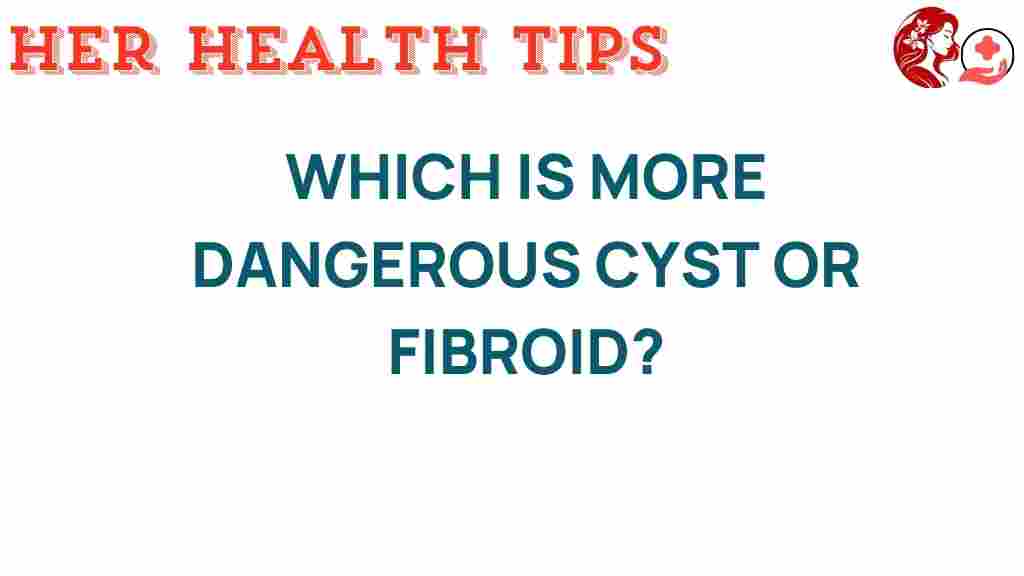Cysts vs. Fibroids: Which Poses a Greater Health Risk?
When it comes to women’s health, understanding the various medical conditions that can affect the reproductive system is crucial. Two common conditions that often cause confusion are cysts and fibroids. While both can occur in the reproductive organs, they are distinct in nature, symptoms, and potential health risks. In this article, we will explore the differences between cysts and fibroids, how they are diagnosed, their treatment options, and ultimately assess which poses a greater health risk.
Understanding Cysts
Cysts are fluid-filled sacs that can develop in various parts of the body, including the ovaries. In the context of women’s health, ovarian cysts are the most common type. They are usually benign and often resolve on their own without treatment. However, some cysts can lead to complications that may pose health risks.
Symptoms of Cysts
Many women with ovarian cysts experience no symptoms. However, when symptoms do occur, they may include:
- Pain in the lower abdomen
- Irregular menstrual cycles
- Fullness or heaviness in the abdomen
- Urinary urgency or difficulty emptying the bladder
- Difficulty with bowel movements
Diagnosis of Cysts
Diagnosing cysts typically involves a pelvic exam and imaging tests, such as an ultrasound. In some cases, blood tests may also be performed to rule out other conditions.
Treatment Options for Cysts
Treatment for cysts depends on their size, type, and symptoms. Options include:
- Watchful waiting: Many cysts resolve without treatment.
- Medication: Hormonal contraceptives may help regulate menstrual cycles and prevent future cysts.
- Surgery: If a cyst is large or causes significant symptoms, surgical removal may be necessary.
Understanding Fibroids
Fibroids, also known as uterine leiomyomas, are non-cancerous growths of the uterus. They can vary in size and number and are quite common among women of reproductive age. While most fibroids do not increase the risk of cancer, they can lead to various symptoms and complications that affect health.
Symptoms of Fibroids
Fibroids may not always cause symptoms; however, when they do, common symptoms include:
- Heavy menstrual bleeding
- Pelvic pain or pressure
- Frequent urination
- Constipation
- Back pain
Diagnosis of Fibroids
Fibroids are typically diagnosed through:
- Pelvic exam: A doctor may feel for abnormalities in the uterus.
- Ultrasound: This imaging test helps visualize the fibroids.
- Magnetic resonance imaging (MRI): This provides detailed images of the uterus.
Treatment Options for Fibroids
Treatment for fibroids also varies based on symptoms and the extent of the condition, including:
- Watchful waiting: If fibroids are asymptomatic, they may not require treatment.
- Medications: Hormonal treatments can help manage symptoms.
- Surgery: In severe cases, options like myomectomy (removal of fibroids) or hysterectomy (removal of the uterus) may be recommended.
Cysts vs. Fibroids: Health Risks Comparison
Both cysts and fibroids can pose health risks, but the nature of these risks can differ significantly.
Health Risks Associated with Cysts
While most ovarian cysts are benign, they can sometimes lead to complications such as:
- Cyst rupture: A ruptured cyst can cause severe pain and internal bleeding.
- Ovarian torsion: A large cyst can cause the ovary to twist, leading to severe pain and potential loss of the ovary.
Health Risks Associated with Fibroids
Fibroids, while generally non-cancerous, can lead to more significant health issues, including:
- Anemia: Heavy menstrual bleeding can lead to anemia due to blood loss.
- Infertility: In some cases, fibroids can interfere with conception or pregnancy.
- Pregnancy complications: Fibroids can potentially cause complications during pregnancy and delivery.
Awareness and Importance of Diagnosis
Awareness of both cysts and fibroids is vital for women’s health. Regular gynecological exams can help detect these conditions early. Here are some key points to consider:
- Women should be aware of their bodies and report any unusual symptoms to their healthcare provider.
- Regular screenings and pelvic exams can help in early diagnosis.
- Understanding personal risk factors, such as family history, can aid in monitoring health.
Step-by-Step Process of Diagnosis and Treatment
For women experiencing symptoms related to cysts or fibroids, here is a general step-by-step process to follow:
- Schedule an Appointment: Contact your healthcare provider to discuss symptoms.
- Pelvic Exam: Undergo a pelvic exam to check for abnormalities.
- Imaging Tests: If necessary, have an ultrasound or MRI to confirm the diagnosis.
- Discuss Treatment Options: Based on the diagnosis, discuss the most suitable treatment options.
- Follow-up: Attend follow-up appointments to monitor the condition.
Troubleshooting Tips for Managing Symptoms
Women experiencing symptoms related to cysts or fibroids can take several steps to manage discomfort:
- Heat Therapy: Applying a heating pad to the abdomen can relieve pain.
- Over-the-Counter Pain Relief: Nonsteroidal anti-inflammatory drugs (NSAIDs) can reduce pain and inflammation.
- Maintain a Healthy Lifestyle: Regular exercise and a balanced diet can help mitigate symptoms.
- Stay Hydrated: Drinking plenty of water can alleviate bloating and discomfort.
Conclusion
In conclusion, both cysts and fibroids are common medical conditions that can affect women’s health. While they may present similar symptoms, their implications and health risks differ significantly. Cysts are often benign and may resolve without treatment, whereas fibroids can lead to more serious complications, especially those related to heavy bleeding and fertility issues. Therefore, understanding the symptoms, seeking timely diagnosis, and exploring treatment options is essential for managing these conditions effectively.
Women’s health is paramount, and awareness of these medical conditions can make a significant difference in health outcomes. If you suspect you have cysts or fibroids, do not hesitate to consult a healthcare provider for a thorough evaluation and personalized treatment plan. For more information on women’s health issues, check out this resource. You can learn more about the importance of regular check-ups here.
This article is in the category Conditions and created by HerHealthTips Team
